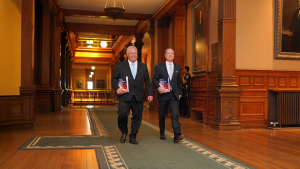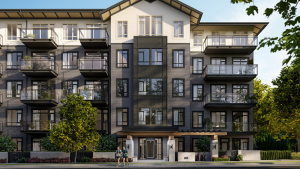Using masonry in building construction can help reduce greenhouse gas emissions and waste, according to speakers at a recent conference organized by the Ontario Building Envelope Council (OBEC). The event included a session on Portland-limestone cement by Rick McGrath of the Cement Association of Canada and on connectors by John Rice of Bailey Metal Products.
Using masonry in building construction can help reduce greenhouse gas emissions and waste, according to speakers at a recent conference organized by the Ontario Building Envelope Council (OBEC).
Bill McEwen, executive director of the Masonry Institute of British Columbia, said masonry is beneficial for indoor air quality and provides thermal mass, meaning that heat created during the day can be “saved” and used overnight, because masonry can moderate temperatures. Therefore, he said, using masonry can reduce the size of the heating, ventilation and air conditioning systems required.
McEwen, a professional engineer who chairs the Canadian Standards Association (CSA) A371 committee on masonry construction, made his comments before an audience of about 60 during a presentation at OBEC’s recent Masonry Standards and Construction event in Toronto.
During his presentation, titled Sustainable Design Using Masonry, McEwen said using masonry can reduce waste.
“Masonry does not have a lot of waste in the first place, because it is modular,” he said.
Another environmental benefit of masonry is the use of Portland-limestone cement, said Rick McGrath, director of codes and standards for engineered structures at the Cement Association of Canada.
Portland-limestone cement is made by grinding regular cement clinker with up to 15 per cent limestone. Both are ground more finely than regular Portland cement. According to the Cement Association of Canada, the manufacturing for Portland-limestone cement reduces greenhouse gas emissions by 10 per cent compared to existing cement, while producing concrete with similar strength and durability to general use cement.
Portland-limestone cement is “the single most available technology we have right now” to reduce greenhouse gas emissions, McGrath said in a separate presentation on Canadian Standards Association (CSA) standard A179 and Portland-limestone cement.
“This is going to be the cement of the future for the North American industry,” McGrath said. He added Portland-limestone cement does not require any new materials, but does require additional investment for additional grinding capacity at mills.
During his presentation, McEwen summarized the criteria and limitations of three environmental ratings systems for construction: Leadership in Energy and Environmental Design (LEED), Green Globes and the Living Building Challenge.
For example, he said, the Living Building Challenge has a list of 14 banned items, one of which is cadmium. During one project, he said, engineers initially wanted to have exposed steel galvanized. However, when you mine zinc, you also get cadmium in the process, and therefore the engineers decided not to galvanize the steel.
The use of galvanized steel to protect from corrosion was a topic of another presentation at Masonry Standards and Construction.
John Rice, corporate product specialist and product development manager at Bailey Metal Products, presented an overview on CSA A-370, the Canadian Standards Association document on Connectors for Masonry.
CSA A-370 includes a section on the amount of zinc that must be applied to steel connectors for corrosion resistance. The standard gives three options, and typically, Option 1 is the standard for interior masonry, Rice said, though he added Option 2, which is a hot dip process, may be required in areas with high moisture. Option 3 is stainless steel.
Rice summarized some of the issues that affect the life of a masonry connector, such as rain, humidity, temperature and the concentration in the air of substances such as sulphur dioxide and chlorides.
He presented tables and graphs that allow engineers to input the weight of the zinc coating and predict the life of a connector. He showed how engineers could also input the desired life of a connector and calculate the weight of the coating required for the connector. Citing information provided by the nickel industry, Rice showed maps plotting the concentration of salt in rain water and a table of the driving rain index, which can be used to decide what materials the connectors should be made of.
In some situations, he said, the specifications will require stainless steel.
Other speakers at Masonry Standards and Construction included Joe Wierzbicki, masonry design coordinator at the Canada Masonry Design Centre, who did a presentation on a software package known as Masonry Analysis Structural System, or MASS.
MASS, which is supported by the Canada Masonry Design Centre, is designed primarily to help structural engineers designing load bearing or structural masonry, including beams, shear walls and out-of-plane walls.
The software includes several modules with diagrams, allowing engineers to enter numbers including loads and find out whether their designs will work.
“If your design does not meet the requirements, you will fail the design,” Wierzbicki said.
The wall module, for example, includes designs for load bearing and wind bearing walls.
MASS was developed by CMDC and the Canadian Concrete Masonry Producers Association (CCMPA). Complimentary versions of MASS are available to designers within the regions covered by CMDC and CCMPA. The cost to those not eligible for a complimentary copy is $750.










Recent Comments
comments for this post are closed